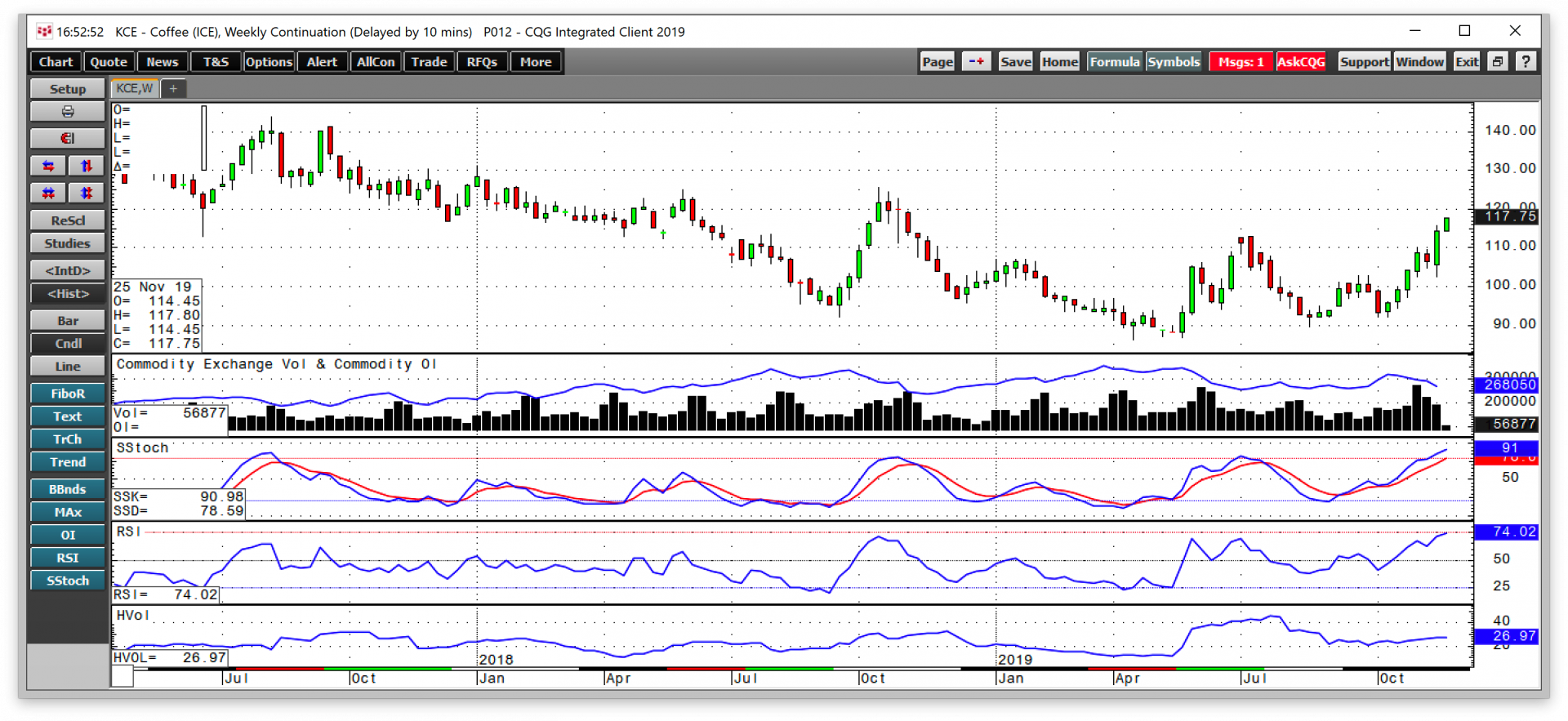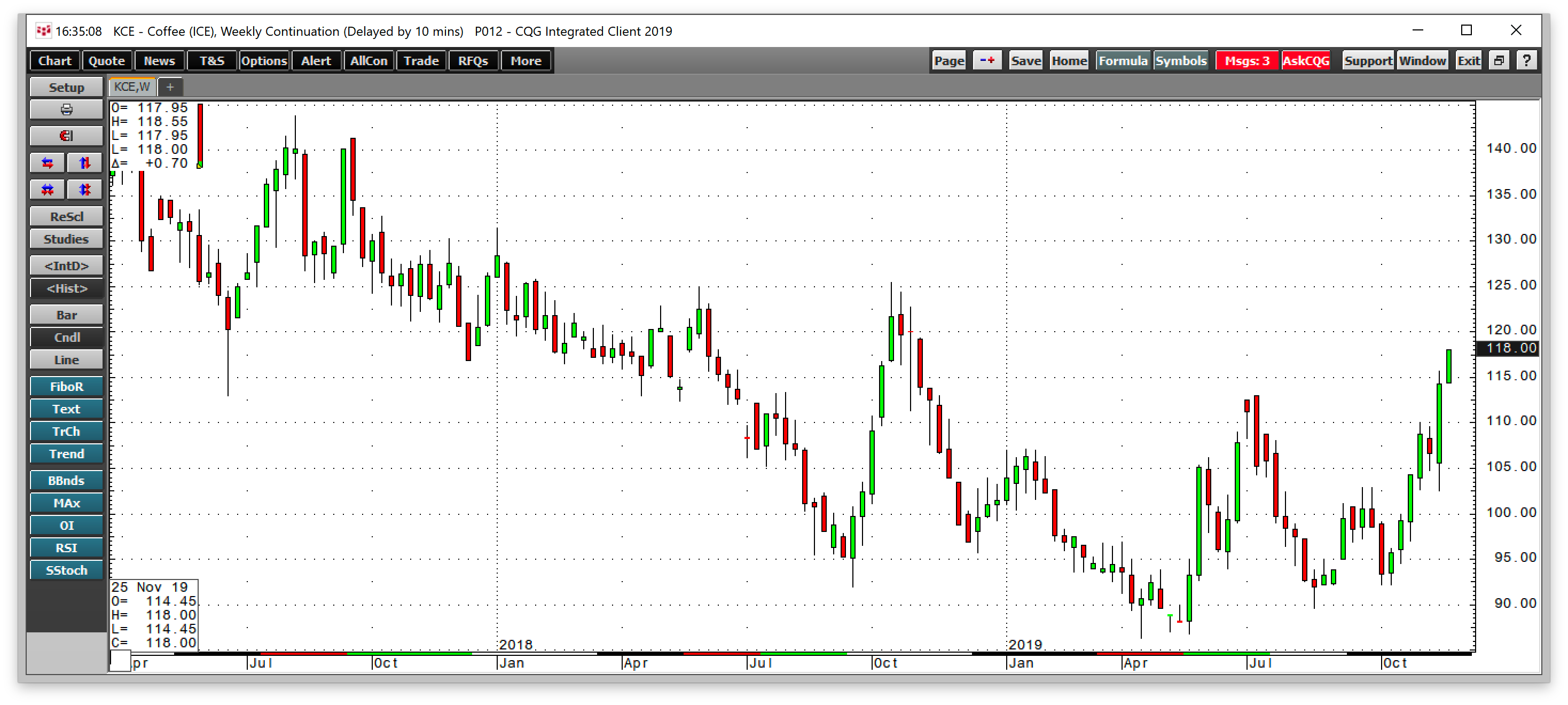The coffee futures market can be one of the most volatile markets in the world. The world’s leading producer and exporter of Arabica beans is Brazil. The weather conditions in the South American nation and the level of Brazil’s currency often causes price variance in the coffee market. While the Arabica futures on the Intercontinental Exchange use the US dollar as a pricing mechanism for coffee, the local production costs in Brazil are in the Brazilian currency. Over the past weeks, the price of coffee futures was percolating on the upside. The nearby ICE futures contract rose to a new high. On November 29, the price rose to a new high for 2019.
Few markets have the potential to move like coffee. The last significant peak in the market came in late 2016 when it reached $1.76 per pound. Since then, the path of least resistance for the price has been lower as coffee futures made a series of lower highs and lower lows for three years. 2020 could be an off year for production in South America, and the price action tuned decidedly bullish.
Coffee reached a low in multiyear low in mid-April and had been making higher lows
When the price of ICE coffee futures hit a low at 86.35 per pound during the week of mid-April, the soft commodity moved to a level that was the lowest level since way back in 2005.
 As the weekly chart highlights, coffee futures have not returned to the April low. In a sign that the fourteen-year low was a bottom, the price has made higher lows since then. In late May, coffee futures reached 86.75, and in mid-August, 89.60 was the low. The next higher low came in early October when the price ran out of downside steam at 92.20 per pound on the nearby futures contract.
As the weekly chart highlights, coffee futures have not returned to the April low. In a sign that the fourteen-year low was a bottom, the price has made higher lows since then. In late May, coffee futures reached 86.75, and in mid-August, 89.60 was the low. The next higher low came in early October when the price ran out of downside steam at 92.20 per pound on the nearby futures contract.
After the most recent low, coffee has posted a gain in six out of the past seven weeks. The price rose to a high at $1.1800 during the final week of November as the soft commodity futures put in a bullish reversal on the weekly chart the previous week. The price fell to a lower level than the previous week and closed at well over its high price. Price momentum and relative strength indicators have risen to overbought conditions. Weekly historical volatility at 27.02% is not all that elevated for the typically wild coffee futures market. Open interest at 280,990 contracts as of November 27 is far below the level when coffee was on it low in April. At that time, the total number of open long and short positions stood at 332,357 contracts.
Rising price and declining open interest is not typically a technical validation of a bullish trend in a futures market. However, over the period, the price rose from 86.35 to $1.18 per pound or over 36.6%.
Concerns over supplies in Brazil
After the long period of bearish price action in the ICE coffee futures market, the decline in open interest is a sign of short covering as the price moved significantly higher. Meanwhile, ICE coffee stocks in the US fell to their lowest level in nearly eighteen months over the recent sessions. Arabica coffee supplies have tightened with a global deficit forecast for the 2019/2020 season. We are coming into an off year in Brazil’s biennial crop cycle.
The uncertainty of the crop and the potential for a crop disease that could lead to an even wider deficit has pushed the price of coffee futures to the highest price of 2019 and since November 2018. We are at a time of the year when uncertainty over the annual crop tends to peak. In 2018, the price rose to a high of $1.2550 in October. The 2016 high came in November at $1.76 per pound. The rally to $2.2550 in 2014 occurred during October. The price of coffee futures was closing in on its first level of technical resistance at the 2018 high at $1.2550 per pound. Coffee moved to the upside on the back of the potential for a deficit in Brazilian production. The Brazilian currency has done little to support the price of the soft commodity.
A rally despite the Brazilian real
A weak Brazilian real tends to weigh on the price of coffee. However, the bullish price action in the soft commodity is coming as the Brazilian real versus the US dollar currency pair is sitting not far off its multiyear low.
The monthly chart of the real-dollar currency pair shows that the Brazilian currency fell from a high at $0.65095 against the US dollar in 2011 to a low at $0.23040 in late 2015. At $0.23690 at the end of November, the Brazilian currency was within striking distance of the low and the level of critical technical support.
 The monthly chart of ICE coffee shows that when the real was at the 2011 high, the price of coffee futures peaked at $3.0625 per pound. As of the end of November, the real-dollar relationship was 63.61% lower. At $1.1800, coffee futures were 61.47% lower than the 2011 high in dollar terms. However, when it comes to the local price of coffee as of the end of November, it was 2.14% higher than in 2011 when coffee futures were over $3 per pound.
The monthly chart of ICE coffee shows that when the real was at the 2011 high, the price of coffee futures peaked at $3.0625 per pound. As of the end of November, the real-dollar relationship was 63.61% lower. At $1.1800, coffee futures were 61.47% lower than the 2011 high in dollar terms. However, when it comes to the local price of coffee as of the end of November, it was 2.14% higher than in 2011 when coffee futures were over $3 per pound.
Coffee rallied despite the weakness in the Brazilian currency on the back of the rising potential of a supply-demand deficit, which could be explosive for the soft commodity.
A key reversal on the weekly chart
From a technical perspective, the price action in the coffee futures market during the week of November 18 was bullish.
 As the weekly chart illustrates, the coffee futures market put in a bullish key reversal trading pattern on the weekly chart for the week of November 18. The price dropped to a lower low than the previous week and then closed above the prior week’s high.
As the weekly chart illustrates, the coffee futures market put in a bullish key reversal trading pattern on the weekly chart for the week of November 18. The price dropped to a lower low than the previous week and then closed above the prior week’s high.
If coffee futures are going to continue to appreciate, supply issues from Brazil or a rise in the value of the Brazilian real versus the US dollar are necessary to propel the price of the soft commodity higher and above the critical technical levels on the upside.
Levels to watch in the coffee futures market
The first level of technical support in the coffee market is at the psychological $1 per pound level. Below there, a low above the early October bottom at 92.20 cents per pound level is necessary to keep the pattern of higher lows intact.
On the upside, the October 2018 high of $1.2550 is the first target. Above there, The August 2017 high at $1.4375 and the November 2016 peak at $1.76 are critical technical resistance levels in the coffee futures market.
Coffee has been making progress on the upside since October when the price rose above $1 per pound. Keeping the soft commodity percolating on the upside will depend on Brazilian supplies that will need to decline during the off year for production during the 2019/2020 crop year.
